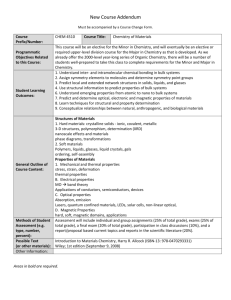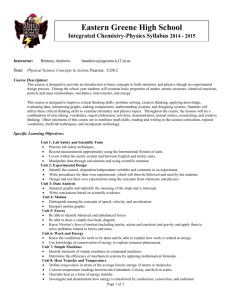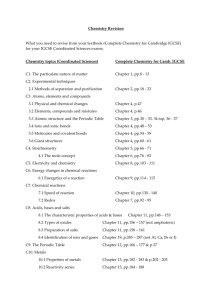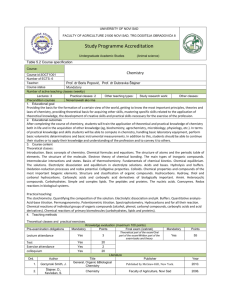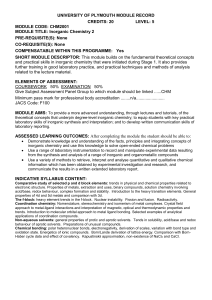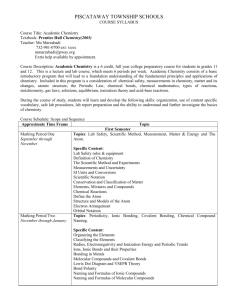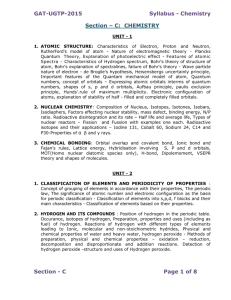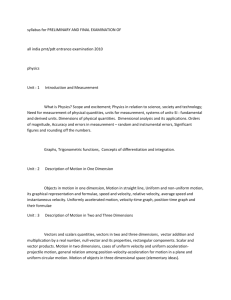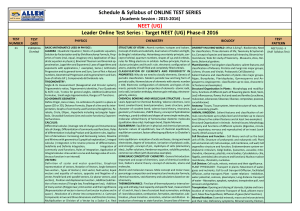Syllabus for Physics - Oriental University, Indore
advertisement
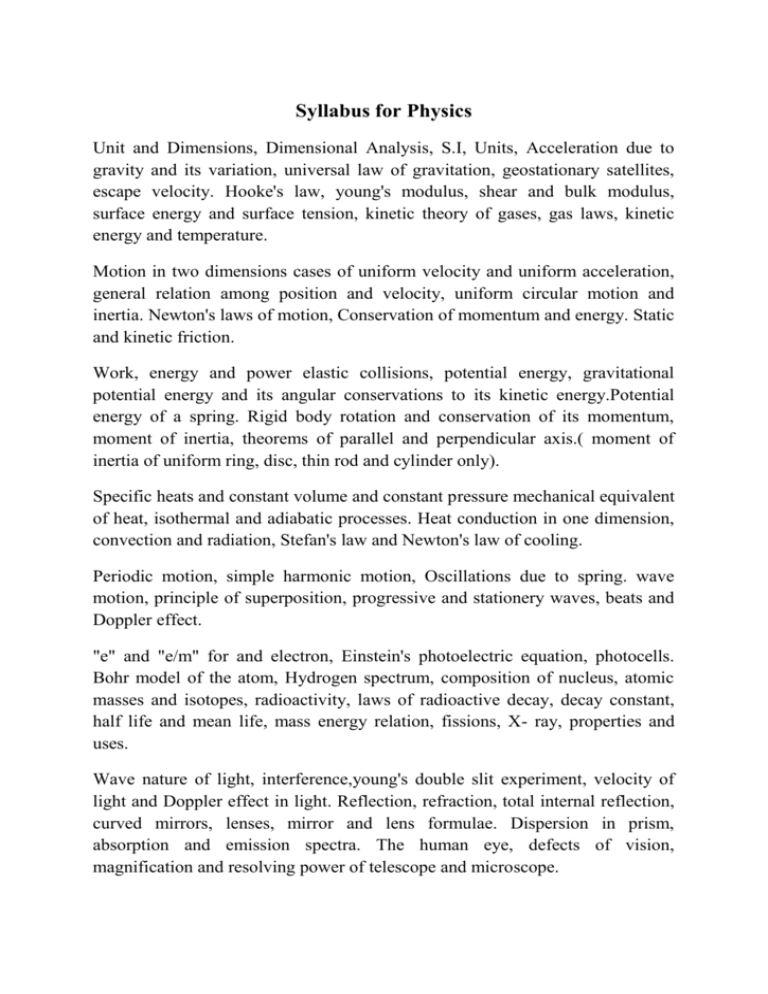
Syllabus for Physics Unit and Dimensions, Dimensional Analysis, S.I, Units, Acceleration due to gravity and its variation, universal law of gravitation, geostationary satellites, escape velocity. Hooke's law, young's modulus, shear and bulk modulus, surface energy and surface tension, kinetic theory of gases, gas laws, kinetic energy and temperature. Motion in two dimensions cases of uniform velocity and uniform acceleration, general relation among position and velocity, uniform circular motion and inertia. Newton's laws of motion, Conservation of momentum and energy. Static and kinetic friction. Work, energy and power elastic collisions, potential energy, gravitational potential energy and its angular conservations to its kinetic energy.Potential energy of a spring. Rigid body rotation and conservation of its momentum, moment of inertia, theorems of parallel and perpendicular axis.( moment of inertia of uniform ring, disc, thin rod and cylinder only). Specific heats and constant volume and constant pressure mechanical equivalent of heat, isothermal and adiabatic processes. Heat conduction in one dimension, convection and radiation, Stefan's law and Newton's law of cooling. Periodic motion, simple harmonic motion, Oscillations due to spring. wave motion, principle of superposition, progressive and stationery waves, beats and Doppler effect. "e" and "e/m" for and electron, Einstein's photoelectric equation, photocells. Bohr model of the atom, Hydrogen spectrum, composition of nucleus, atomic masses and isotopes, radioactivity, laws of radioactive decay, decay constant, half life and mean life, mass energy relation, fissions, X- ray, properties and uses. Wave nature of light, interference,young's double slit experiment, velocity of light and Doppler effect in light. Reflection, refraction, total internal reflection, curved mirrors, lenses, mirror and lens formulae. Dispersion in prism, absorption and emission spectra. The human eye, defects of vision, magnification and resolving power of telescope and microscope. Elementary ideas of conductor, semi conductor and insulator, intrinsic and extrinsic semiconductors, p-n junction as a rectifier. Bar magnet, lines of force, torque on a bar magnet due to magnetic field, earth's magnetic field , tangent galvanometer, vibration magnetometer. Force on a moving charge in a magnetic field(Lorentz force), magnetic moment of a current loop, effect of a uniform magnetic field of a current loop, forces between two currents, moving coil, galvonometer, ammeter and voltmeter. Electromagnetic induction induced e.m.f., Faradays law, Lenz's law, self and mutual inductance alternating currents, impedance and reactance, growth and decay of current in L-R circuit, elementrary idea if dynamo and transformer Coulomb's law of electrostatic, dielectric constant, electric field and potential due to a point charge, dipole, dipole field, Guass's law in a simple geometrics. Electrostatic potential, capacitance, parallel plate and spherical capacities in series and parallel, energy of a capacitor. Electric current, Ohm's law, Kirchhoffs laws, resistances in series and parallel temperature dependence of resistance, Wheat stone bridge, potentiometer. Measurement of voltage as currents. Electric power, heating effects of currents, chemical effects and law of electrolysis thermoelectricity Blot Savart law, magnetic fields due to a straight wire circular loop and solenoid. Syllabus for Chemistry General & Physical Chemistry Structure of atom: constitutions of nucleus: Bohr's atom model: quantum numbers Aufbau principle, electronic configuration of elements (upto Kr): DeBroglie relation, shapes of orbitatis. Chemical bond: electrovalent, covalent and coordinate bonds, hybridisation(sp): hydrogen bond: shapes of molecules( VSEPR theory): bond polarity, resonance, elements of VBT a MOT. Solid state: crystal lattices, unit cells, structure of ionic compounds: close packed structure ionic radi, imperfections (point defects): properties of solids. Solutions: models of expressing concentrations of solutions: types of solutions, Raoult's law of colligative properties, non- ideal solution, abnormal molecular weights. Chemical equillibrium: chemical equillibrium, law of mass action: Kp and Kc: Le Chatelier principle and its applications. Ionic equilibrium in solutions, solubility product, and common ion effect, theories of acids and base hydrolysis of salts: PH: buffers. Nuclear chemistry: radio active radiations: half-life, radioactive decay, group displacement law structure and properties of nucleus: nucleus reaction, disintegration series artificial transmutation: isotopes and their uses: radiocarbon dating. Thermochemistry and thermodynamics: energy changing due to chemical reaction: instrinsic energy enthalpy, first law of thermodynamics: Hess's law heats of reactions: Second law of themodynamics: energy free energy: spontaneity of a chemical reaction: free energy change and chemical equilibrium: free energy as energy available for useful work. Chemical kinetic: rate of a reaction, factors affecting the rates, rate constant rate expression, order of reaction, first order rate constant expression and characteristics, Arrhenous equation. Electrochemistry: oxidation, oxidation number and ion- electron methods. Electrolytic conduction, Faraday's law: voltaic cell, electrode potentials, electromotive force, Gibb's energy and cell potentials. Nernest equation, commercial cells, fuel cell, electrochemical theory of corrosion. Surface chemistry, colloids and catalysis: Adsorption, colloids (types preparation and properties), Emulsions, Micelles, catalysis types and characteristics. Inogranic Chemistry: Chemical periodicity s.p.d and f-block elements, periodic table: periodicity: atomic and ionic radii valency, ionization energy, electron affinity electro negativity, metallic character. Comparative study of elements: comparative study of following families of elements 1. Alkali metals 2. Alkaline earth metals 3. Nitrogen family 4. Oxygen family 5. Halogens 6. Noble gases. Transition metals: electronic configuration of 3d metal ions, oxidation states, other general characteristics properties, potassium permanganate, potassium dichromate. Co-ordination compounds: simple nomenclature, bounding and stability, classification and bonding in organometallics. Principle and metallurgical operations: furnaces, ore concentration, extraction, purification metallurgies of Na, Al, Fe, Cu, Ag, Zn and Pb and their properties. Chemical analysis: chemistry involved is simple inorganic quilitative analysis:calculations based on acid base titrimetry. Organic Chemistry: Nomenclature, physical chemical properties, correlation of physical properties with structure properties and uses of heloalkanes, halobenzenes, alcohols and phenols: general ideas of some polyhalogen compounds viz dicholorothanes dichloroethers, chloroform, carbon tetrachloride D.D.T benzene hexachloride. Nomenclature, methods of preparation, chemical properties correlations of physical properties with structures and uses of elhers aldehydes, ketones, corboxylic acids and their derivatives, brief account of the chemistry of cyanides isocyanides, amines and nitro compounds Calculations of empirical and molecular formula of organic compounds, nomenclature of organic compounds, common functional groups isomerism structure and shapes of alkanes, alkanes and benzene. Preparation properties and uses of alkynes, alkynes, benzene petroleum, cracking octane number, gasoline additives. Polymers: classification: preparation and uses of common natural and synthetic polymers. Bio-molecules: classification, structure and biological importance of carbohydrates amino acids, peptides, proteins and enzymes, nucleic acids and lipids Syllabus for Mathematics: Trigonometry: Trigonometry functions and their graphs, addition and subtraction formulae; formulae involving multiple and submultiple angles, general solutions of trigonometrical equations, relation between sides and angles of a traingle. Solution of traingles, inverse: trignometrical functions, height and distance(simple problems). Co-Ordinate Geometry of Two Dimensions: Rectangular cartesian coordinates, straight line, pair to straight lines, distance of a point from a line, angle between two lines. Circle, tangents and normals, system of circles. Conic section, parabola, ellipse and hyperbola in standard forms with elementary properties, tangents and normals. Co-Ordinate Geometry of Three Dimensions Rectangular co ordinate system, direction cosines and direction ratios, equation of place in standard forms.Perpendicular distance from a point, equation of a line angles between two lines. Algebra: Algebra of Complex numbers, Graphical representation of complex numbers modules, and argument of complex numbers, conjugated of a complex number, triangle inequality, cube roots of unity, arithmetic, geometric and harmonic progression. Arithmetic, geometric and harmonic means between two numbers.Sum of squares and cubes of first natural numbers.Theory, geometric equation, relations between roots and coefficients. Quadratic expressions, quadratic equations in one variable, permutations and combinations. Bionomial (any index) theorem exponential and logarithmic series, determinants up to third order and their order and their elementary properties matrices types of matrices, adjoint and inverse of matrix, elementary, applications is solving simultaneous equation upto three variables Vector Algebra: Definition of vector, addition of vector, components in three dimensional space, scalar and vector products. triple products, simple applications in geometry and mechanics. Statistics: Probability addition and multiplication laws, conditional probability, Binomial distribution, simple problems in correlation and regression. Numerical Methods: Solution of euation by the methods of bisection, false position and Newton Raphson. Numerical integration by trapezoided and Simpson's rule. Linear Programming: Definition and formation of linear programming problems, solution by graphical Method Differential Calculus: Function, polynomial, rational trignometric, logarithmic and exponential, inverse functions. Limit continuity and differentiability of functions, differentiation of rational, trigonometric and exponential functions. Application of derivative in elementary problem in mecharics, increasing and decreasing functions. Maxima and Minima of function of one variable, Roll's theorem and mean value theorem. Integtral Calculus: Integration as the inverse process of differentation, integration by parts. By substitution and by partial fraction definite integral. Areas under simple curves. Differential Equations: Formulation of differential equation, ordered degree solution of differential equations by separation of variable method. Homogeneous form linear differential equation of first order
